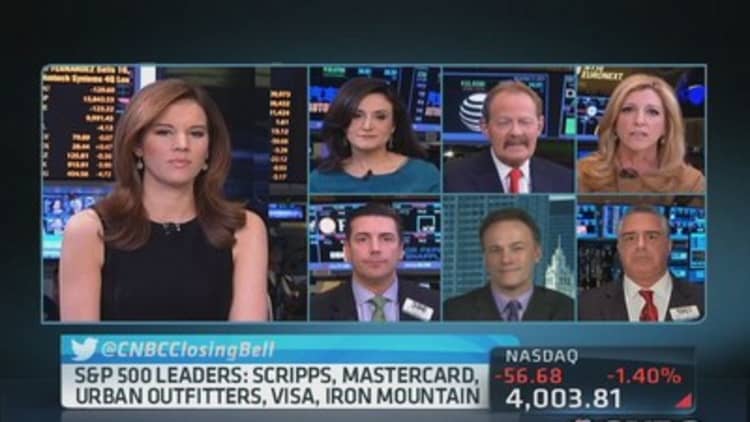
The U.S. economic recovery hasn't reached the self-sustaining momentum deemed necessary to warrant a tapering of the Federal Reserve's stimulus program in 2014, according to Australia's Westpac Bank - a minority view at odds with mainstream expectations.
"This view is driven by our sense that both employment data and inflation measures simply do not justify Fed tapering any time soon," Rob Rennie, Westpac's global head of FX strategy in Sydney, told CNBC in emailed comments last week.
Expectations are building that the Fed may start cutting its $85-billion-a-month bond-purchase program earlier than expected, possibly as soon as next week's policy meeting. Recent data indicated economic activity has remained resilient despite October's bruising budget battles culminating in a government shutdown that hurt confidence among businesses and consumers, while rising mortgage rates weighed on the housing market.
(Read more: Afraid of the taper? Here's how you can beat it)
"If we are wrong and the Fed does taper, it will be a 'start-stop' affair and it will be at least partially replaced by other forms of monetary stimulus," Westpac's Rennie said. "By 2015, we do see the U.S. economy getting closer to escape velocity and taper happening then."
Westpac's contrarian view goes against the grain of the majority of economists, some of which believe the Fed will start dialing back stimulus as soon as next week's meeting of the Federal Open Market Committee (FOMC).
"To some extent, they do have a point," said Martin Lakos, Division Director at Macquarie Private Wealth in Sydney, when asked about Westpac's view. "Clearly the Fed has made it very clear that they've got to see sustainable economic data before they're really going to act."
Thirty-two economists expect the U.S. central bank to act in March, according to a Reuters poll of more than 60 economists this week. Twenty-two said it would scale back its monthly bond-buying program in January and only 12 economists expect an announcement next week.
The Fed's monetary policy setting body will meet on Dec. 17-18 and is scheduled to release its summary of economic projections. Fed Chairman Ben Bernanke will hold a press conference after the FOMC's statement release.
The U.S. economy created 200,000 jobs in October and 203,000 last month, beating forecasts, and pushing the unemployment rate down to a five-year low of 7 percent while factory activity in November accelerated at its fastest pace in more than two years.
(Read more: Waiting for taper start? You may have missed it)
But the labor market may be in worse shape than the numbers suggest, Rennie says, highlighting unemployment remains above the Fed's 6.5 percent threshold meaning more consistently strong jobs growth is required before policymakers can start removing support.
'Headline Jobs'
About 250,000 net new jobs a month are needed just to keep even with population growth, former U.S. Labor Secretary Elaine Chao, who served under the George W. Bush administration, told CNBC on Dec. 6.

"While headline jobs data has improved, any look at the detail shows clear weakness," Rennie said. "Look at the participation rate…what has been most concerning to us about this weakness in job creation is that under twenty-fives, whose exit to study drove the participation rate lower between 2006 and 2011, are largely yet to return to work."
He added: "Absent a material change in employment opportunities, this trend will create a persistent drag on growth, most notably through the housing market and consumption associated with household formation."
(Read more: Blink and you'll miss it! The mini-taper)
The labor-force participation rate - a measure of both people who are working and those who are actively looking - fell to 62.8 percent in October, the lowest in more than three decades although the closely-watched indicator did manage to bounce back last month from October's multi-decade low.
Though job creation is gaining momentum, many argue that the jobs added are not the kind that will offer the economy a meaningful longer-term boost.
The majority of the 203,000 jobs created in November - 152,000 – were in "lowly paid domestic non-tradable services," wrote Paul Craig Roberts, former Assistant Secretary of the U.S. Treasury in the Reagan Administration, in a Dec. 11 paper published on the website of Centre for Research on Globalization. Roberts defines 'non-tradable' as jobs that do not produce a service that can be exported.
As Rennie at Westpac sees it, the only clear justification for a Fed taper is that such prolonged easy monetary policy has reached the stage where it's benefiting Wall Street more than Main Street.
(Read more: Get ready, here it comes: A December taper)
"QE is not working as designed," he said, referring 'quantitative easing' - the Fed's unconventional monetary policy. "If it isn't working (outside of dragging S&P higher), why carry on doing it? Thus the justification for taper is based on the declining marginal benefit being less than the rising marginal risk to the Fed's balance sheet and credibility."
Macquarie's Lakos agrees: "We're still in a position where there's a huge imbalance in monetary policy - that is, you've got standard cash rates, very, very low, plus the support of QE. And so removal of QE will start to move is back to a normalized, balanced operations."
— By CNBC's Sri Jegarajah. Follow him on Twitter: @cnbcSri


